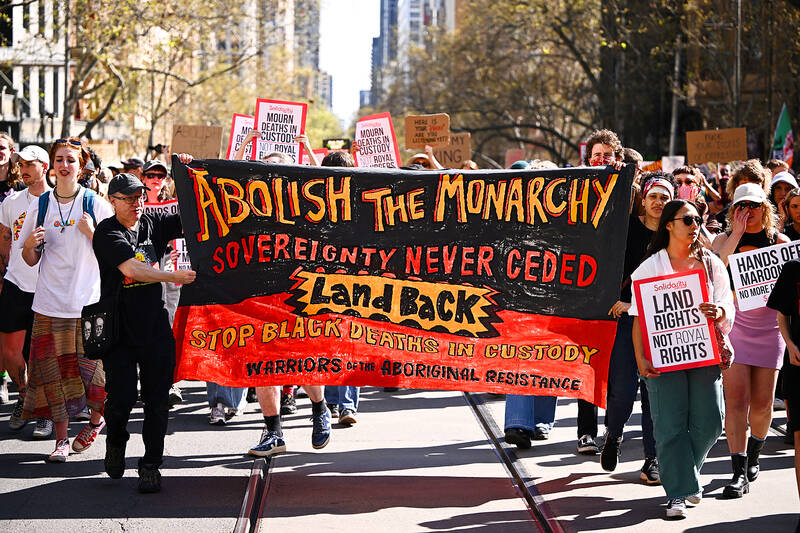An Australian national day of mourning for the late Queen Elizabeth II yesterday centered on Parliament House, where dignitaries placed sprigs of golden wattle — the national floral emblem — in a wreath.
The focus at the ceremony at parliament’s Great Hall was a portrait of the former monarch of Britain and Australia in a yellow dress adorned with golden wattle motifs that she wore on her first night in Australia in 1954, known as the Wattle Painting, created by Australian artist William Dargie.
The queen’s death on Sept. 8 came in the Southern Hemisphere spring when wattle blooms, its golden flowers and green leaves reflecting Australia’s national colors in what has become a symbol of unity.

Photo: EPA-EFE
The government declared yesterday a nationwide public holiday and the ceremony was attended by Australian Prime Minister Anthony Albanese and Governor-General David Hurley, King Charles III’s representative in Australia. Both had returned on Wednesday from the queen’s funeral in London.
The holiday has been marked by some protests that focused on the harm British colonization caused indigenous Australians. Australia is one of the few former British colonies that never struck a treaty with the indigenous population.
Hurley used his speech to highlight the reactions of some indigenous Australians, who die younger and are more likely to be imprisoned than any other ethnic minority there.
“I acknowledge that her passing has prompted different reactions for some in our community,” Hurley said. “I’m conscious to respect that the response of many First Nations Australians is shaped by our colonial history and broader reconciliation journey, that is a journey we as a nation must complete.”
The government plans to change the Australian constitution with a referendum that would create a mechanism for indigenous people to consult parliament about policies that affect their lives.
Indigenous responses to the queen’s death have been mixed. Indigenous dancers and singers started the Parliament House ceremony.
Albanese, who wants Australia to replace the British monarch with an Australian head of state, spoke about how the nation had changed since 70 percent of the population turned out to see the queen in 1954.
“Perhaps the greatest tribute we can offer her family and her memory is not a marble statue or a metal plaque,” Albanese said. “It is a renewed embrace of service to community.”
Two opinion polls published since the queen’s death show most Australians want to remain a constitutional monarchy. Advocates for an Australian republic say this is a temporary reaction to the intense media coverage of a popular monarch.
Political leaders past and present, judges, military chiefs and other dignitaries were among 700 guests at the service.
The queen officially opened Parliament House in 1988. Her father opened a temporary Parliament House nearby in 1927. King George VI was then Duke of York, making his daughter the first reining monarch to visit Australia.

BOMBARDMENT: Moscow sent more than 440 drones and 32 missiles, Volodymyr Zelenskiy said, in ‘one of the most terrifying strikes’ on the capital in recent months A nighttime Russian missile and drone bombardment of Ukraine killed at least 15 people and injured 116 while they slept in their homes, local officials said yesterday, with the main barrage centering on the capital, Kyiv. Kyiv City Military Administration head Tymur Tkachenko said 14 people were killed and 99 were injured as explosions echoed across the city for hours during the night. The bombardment demolished a nine-story residential building, destroying dozens of apartments. Emergency workers were at the scene to rescue people from under the rubble. Russia flung more than 440 drones and 32 missiles at Ukraine, Ukrainian President Volodymyr Zelenskiy

COMPETITION: The US and Russia make up about 90 percent of the world stockpile and are adding new versions, while China’s nuclear force is steadily rising, SIPRI said Most of the world’s nuclear-armed states continued to modernize their arsenals last year, setting the stage for a new nuclear arms race, the Stockholm International Peace Research Institute (SIPRI) said yesterday. Nuclear powers including the US and Russia — which account for about 90 percent of the world’s stockpile — had spent time last year “upgrading existing weapons and adding newer versions,” researchers said. Since the end of the Cold War, old warheads have generally been dismantled quicker than new ones have been deployed, resulting in a decrease in the overall number of warheads. However, SIPRI said that the trend was likely

‘SHORTSIGHTED’: Using aid as leverage is punitive, would not be regarded well among Pacific Island nations and would further open the door for China, an academic said New Zealand has suspended millions of dollars in budget funding to the Cook Islands, it said yesterday, as the relationship between the two constitutionally linked countries continues to deteriorate amid the island group’s deepening ties with China. A spokesperson for New Zealand Minister of Foreign Affairs Winston Peters said in a statement that New Zealand early this month decided to suspend payment of NZ$18.2 million (US$11 million) in core sector support funding for this year and next year as it “relies on a high trust bilateral relationship.” New Zealand and Australia have become increasingly cautious about China’s growing presence in the Pacific

Indonesia’s Mount Lewotobi Laki-Laki yesterday erupted again with giant ash and smoke plumes after forcing evacuations of villages and flight cancelations, including to and from the resort island of Bali. Several eruptions sent ash up to 5km into the sky on Tuesday evening to yesterday afternoon. An eruption on Tuesday afternoon sent thick, gray clouds 10km into the sky that expanded into a mushroom-shaped ash cloud visible as much as 150km kilometers away. The eruption alert was raised on Tuesday to the highest level and the danger zone where people are recommended to leave was expanded to 8km from the crater. Officers also